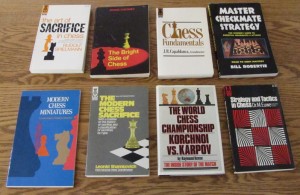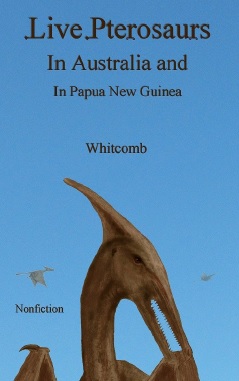First let’s briefly examine two chess books for intermediate and advanced players. For beginners who know the rules of the game but little else about winning, look at the short book review at the bottom of this post (Beat That Kid in Chess).
Eight of the many chess books in the Harman Chess Club, West Valley City, Utah
The Art of Sacrifice in Chess, by Rudolf Spielmann, is highly rated by all readers who contributed their comments on Amazon, and five of those fifteen reviews are by verified purchasers. Interesting to tell, only two of those fifteen reader-reviews are of the newly published 2015 edition, meaning thirteen highly positive comments were of the older edition which used the old descriptive chess notation (both of those reviews were verified purchasers). That speaks highly of both editions of this chess book. Just be aware that this book is not for beginners.
The Bright Side of Chess, on the other hand, has only one customer review on Amazon, and that Verified Purchaser said only this: “Really fun book.” Yet that five-star review sums up the book nicely. Look at one paragraph quoted from the Anecdotes chapter:
Temporarily stranded in a little German town, Dr. Lasker, Chess Champion of the World, wandered into the local chess club. One of the members, who as it happened was the club champion, courteously invited him to a game—evidently not suspecting the identity of the meek-looking stranger.
They played two games, and both times Lasker steered the opening into queer, unconventional channels, from which emerged bewildering complex mid-games. As was usually the case against even the greatest masters, it was Lasker who saw further ahead and picked his way unerringly through the labyrinth of complications.
The club champion was surprised by his two defeats, and said to Lasker in perplexed admiration, “You must be pretty strong to beat me, for they call me the Lasker of this club, and you know what that means!”
The author, Irving Chernev, wrote chess books that became extremely popular, probably partially from including fun anecdotes like that. (The Bright Side of Chess is another recently republished work from an old edition that was probably in descriptive notation.)
Beat That Kid in Chess
Beginners who already know how to play the game—they’ll get the most benefit from this chess book. It teaches those most important tactics and good habits that quickly prepare the beginner to beat another beginner.
Yet Beat That Kid in Chess is not a collection of cheap tricks that work only against opponents who know almost nothing about winning. The principles taught can be used in the future, as the reader advances beyond the beginner stage.
This chess book, published September 2, 2015, uses a new system of instruction, the NIP method (nearly-identical positions). This naturally leads the reader to recognize the important differences in chess positions, essential differences.
###
.
One of the three books reviewed is Beat That Kid in Chess:
This new book is best suited for the beginner who already knows how to move the pieces around but would like to win some chess games. It could be a great book for such a player.
This chess book is balanced in depth and breadth, with lessons on how to checkmate your opponent, gain a material advantage over another beginner, promote a pawn to a queen, pin one of your opponent’s pieces, make a knight fork, avoid becoming checkmated, and much more. It emphasizes what a beginner most needs to know and understand, as soon as possible.
[The Swiss system in a chess tournament] is the most common method of pairing opponents when many players are competing, especially in open tournaments. It usually allows the event to be completed in only a few days.
.




